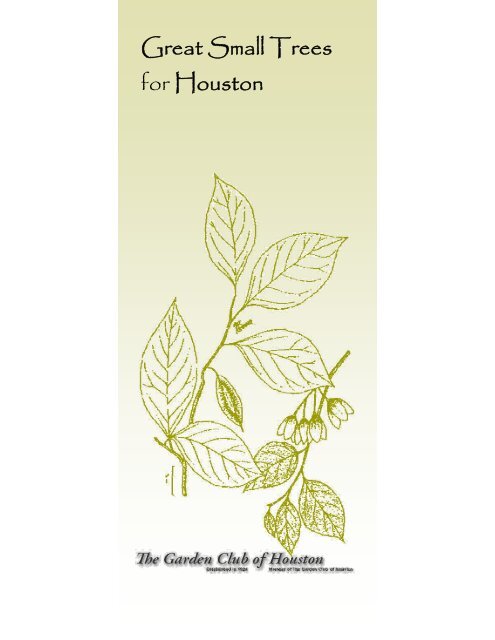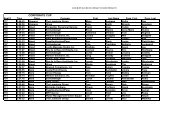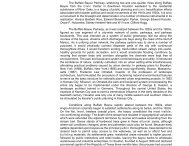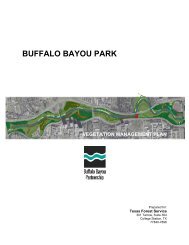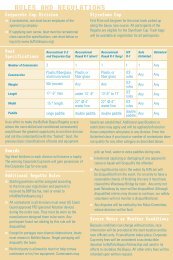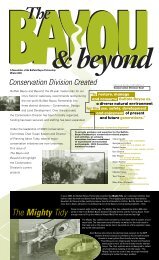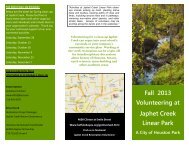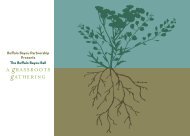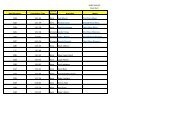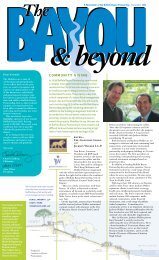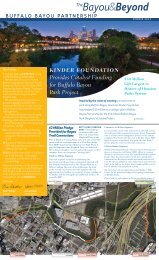Great Small Trees for Houston - Buffalo Bayou Partnership
Great Small Trees for Houston - Buffalo Bayou Partnership
Great Small Trees for Houston - Buffalo Bayou Partnership
- No tags were found...
Create successful ePaper yourself
Turn your PDF publications into a flip-book with our unique Google optimized e-Paper software.
<strong>Great</strong> <strong>Small</strong> <strong>Trees</strong><strong>for</strong> <strong>Houston</strong>
To celebrate the Garden Club of America’sCentennial in 2013, The Garden Club of<strong>Houston</strong> has created a list of <strong>Great</strong> <strong>Small</strong><strong>Trees</strong> <strong>for</strong> <strong>Houston</strong>.Our city sits at the convergence of several majorecosystems, and our climate encourages the healthygrowth of an extraordinary variety of plants,especially trees. Over the years, the Garden Club of<strong>Houston</strong> has researched an untold number of trees.Our recommended trees have been sold at our popularBulb & Plant Mart, and more importantly, have beengrown in members’ gardens. Our collective experienceis reflected in <strong>Great</strong> <strong>Small</strong> <strong>Trees</strong> <strong>for</strong> <strong>Houston</strong>. It isour hope that this list will be useful not only to publicentities who build parks and trails, but also todevelopers, civic associations, growers, and anycitizens interested in making our public spaces andprivate gardens more economical, sustainable, andbeautiful.The <strong>Great</strong> <strong>Small</strong> <strong>Trees</strong> were selected based onthree criteria:• native to our area and likely to thrive with littlemaintenance;• exceptional beauty and the widest possiblerange of seasonal interest; and• habitat benefits, particularly <strong>for</strong> birds.We chose to focus on the small trees that are oftenmissing from our public spaces and to emphasize treesthat are typically commercially available. To bepractical in a public space or a private garden, a treemust require little maintenance and thus beinexpensive over the longer term. <strong>Houston</strong>, a birdwatcher’s paradise, is on a major flyway, so plantingsmust provide shelter and food <strong>for</strong> birds if we are tosustain this key community characteristic. The bestway to achieve all these goals is to use native oradaptive plants found in our general region.Most importantly, these trees are beautiful. They canbring extraordinary variety and charm to ourlandscapes.The <strong>Great</strong> <strong>Small</strong> <strong>Trees</strong> offer a remarkable mix o<strong>for</strong>namental interest from early spring through fall.
Selection of <strong>Small</strong> <strong>Trees</strong>Anacahuita – Texas Wild OliveCordia boissieriAmerican HollyIlex opacaChalk MapleAcer leucodermeEastern RedbudCercis canadensisIronwoodCarpinus carolinianaMexican PlumPrunus mexicanaNative Fringe TreeChionanthus virginicusParsley HawthornCrataegus marshalliiPossum-HawIlex deciduasRusty Blackhaw ViburnumViburnum rufidulumSouthern Wax MyrtleMyrica ceriferaSweet Bay MagnoliaMagnolia virginianaTwo-wing Silver BellHalesia dipteraYaupon HollyIlex vomitoriaAnacahuita –Texas Wild OliveCordia boissieriAmerican HollyIlex opacaChalk MapleAcer leucodermeLight: full sun to partial shadeSoil: sands, loams, and claysMoisture: well drained, drought tolerant onceestablished<strong>Bayou</strong> Site: top bankGrowth Habit: persistent to evergreen, fast,sensitive to cold – will freeze to roots below 20degrees, plant in protected areaFlower: showy 2 inch white flowers with yellowthroat, will flower all year long with enough waterFruit: drupes, white turning to purpleSize: 12 to 24 ft. tall, 25 ft. wideForm: rounded crown with short trunkSpecial Interest: fruit enjoyed by birds and small mammalsLight: full sun to partial shadeSoil: sands, loam, acid soilsMoisture: well drained<strong>Bayou</strong> Site: top bankGrowth Habit: evergreen, slow growing, longlivedFlower: inconspicuousFruit: red berries on female, need male treenearby <strong>for</strong> pollinationSize: 15 to 35 ft., occasionally to 60 ft.Form: triangular crown that broadens with ageSpecial Interest: good screening plant, berries enjoyed by many birds andsmall mammals, larval host plant <strong>for</strong> butterfly, excellent nesting tree <strong>for</strong> birdsFruit: wings ¾ inches longSize: 12 to 20 ft.Light: partial sunMoisture: dry, will need supplemental water insevere droughtSoil: rich loam, needs good drainage<strong>Bayou</strong> Site: upper slopeGrowth Habit: deciduous, fast, rounded crown,whitish barkFlower: small in April
Eastern RedbudCercis canadensisLight: sun to part shadeSoil: sands, loams and clayMoisture: well drained, moderate moisture, will needsupplemental water during severe drought<strong>Bayou</strong> site: top bankGrowth Habit: deciduous, fast growthFlower: March – pink flowers about ½ inch long, inclusters along branches be<strong>for</strong>e leaves appearFruit: seed podsSize: 10 to 20 ft.Form: small tree, spreading, flat or slightly rounded crown, usually single trunkSpecial Interest: one of our prettiest flowering trees; leaves are source offood <strong>for</strong> butterfly larvae; flowers are nectar source <strong>for</strong> butterflies, moths, andbees; seeds are eaten by birdsIronwoodCarpinuscarolinianaLight: sun to partial shadeSoil: loam, clayMoisture: well drained<strong>Bayou</strong> Site: upper slope, top bankGrowth Habit: deciduous, slow growingFlower: male and female flowers <strong>for</strong>m in fall, persistthrough winter, and open in springFruit: nutlets in 2 inch clustersSize: 15 – 30 ft., 20-25 ft. wideForm: open crown with drooping thin branchesSpecial Interest: yellow, orange, and red fall color; heartwood is very strong -, once used by Indians <strong>for</strong> bows; flowers and seeds enjoyed by many birds; alsocalled American Hornbeam or Musclewood due to smooth, sinewy trunk,Mexican PlumPrunus mexicanaLight: full sun to partial shadeSoil: sandy, loam, clayMoisture: dry to moist, well drained, drought tolerant,tough tree<strong>Bayou</strong> Site: slopes or top bankGrowth Habit: deciduous, moderate to fast growthin right locationFlower: fragrant, showy white flowers be<strong>for</strong>e leavesappearFruit: small round fruit, green turns purpleSize: 15 to 30 ft. tall to 25 ft. wideForm: single trunk, blue-gray bark with dark horizontal striations, broad crownSpecial Interest: fruit enjoyed by birds and mammals; larval host <strong>for</strong> TigerSwallowtail butterfly and Cecropia moth larvae; fragrant flowers attract beesand butterfliesLight: sun to partial shade, prefers dappled shadeMoisture: prefers moist site but is adaptable, willneed supplemental water during severe droughtSoil: moist, fertile, acid soil, sandy loam<strong>Bayou</strong> site: along upper slope or top bankGrowth Habit: deciduousFlower: March - fragrant, 5-10 inch white panicles,drooping in clustersFruit: August - October on female plants, dark blue topurple drupesFringe TreeChionanthus Size: 15 to 20 ft.virginicus Form: slender trunk or often multi-trunked, withirregular, rounded crownSpecial Interest: fruit loved by birds; also known as Grancy Gray Beard
ParsleyHawthorneCrataegusmarshalliiLight: sun to partial shade, flowers better with moresunSoil : sands, loam, claysMoisture: well drained but will tolerate seasonalpoor drainage, drought tolerant once established<strong>Bayou</strong> Site: lower slope, or top bankGrowth Habit: slow but long lived, deciduousFlower: 1 inch white flowers, showyFruit: small red haws throughout winter, plant morethan one tree <strong>for</strong> better fruitingSize: 15 to 30 ft. tall, 25 ft. wideForm: wide-spreading, slender branches and broad, irregular, open crown withparsley like leaves, some branches have thornsSpecial Interest: birds enjoy the fruit in the winter; attracts butterflies; thethorny branches help protect nesting birds from predators.Possum HawIlex deciduasLight: shade, will fruit best in partial shade to sunSoil: adaptable, sands, loams and claysMoisture: well drained, seasonal poor drainagetolerated, drought tolerant<strong>Bayou</strong> Site: top bank or slopesGrowth Habit: moderate, deciduousFlower: small white flowers in springFruit: bright red-orange drupes on female plants thatpersists into the winter, females need a malepollinator <strong>for</strong> good fruit setSize: 8 to 20 ft.Form: loose; rounded, many horizontal and ascending branchesSpecial Interest: abundant red berries on bare branches in winter are a showstopper; fruits are eaten by birds and small mammals; good nest treeRusty BlackhawViburnumViburnumLight: partial shade to full sunSoil: sand, loam and clay, well drainedMoisture: drought tolerant<strong>Bayou</strong> Site: upper slope of top bankGrowth Habit: deciduous, slow growingFlower: white flower clusters 4 inches wide in springFruit: blue/black drupes ½ inch long in fallSize: 10 to 30 ft. tall depending on environment, canget to 35 ft. wideForm: shrub <strong>for</strong> a long time, becomes a tree, singletrunk with broad crownSpecial Interest: fruit loved by many birds and mammals; flowers attractbutterflies and bees; leaves eaten by butterfly larvae; fall color; glossy leatheryleaves. This can be difficult to start, but it is a favorite of many of our experts.Good drainage is key.
Southern WaxMyrtleMyrica ceriferaLight: full sun to partial shadeSoil: loam, clay, adaptableMoisture: will tolerate poor drainage, droughttolerant once established<strong>Bayou</strong> Site: slopes, top bankGrowth Habit: evergreen, fast growingFlower: inconspicuousFruit: pale bluish berriesSize: 10 to 20 ft. tall, 10 to 15 ft. wideForm: large shrub or small multi-trunked treeSpecial Interest: aromatic leaves; natural suckeringhelps with erosion control; dense growth is excellentnesting <strong>for</strong> birds; over 40 species of birds enjoy the fruit; can be used as anattractive tall screen or as a specimen treeSweet BayMagnoliaMagnoliaLight: full sun to part shadeSoil: sands, loams, clay, acid soils preferredMoisture: moist soils preferred, drought tolerant onceestablished<strong>Bayou</strong> Site: slopes, top bankGrowth Habit: semi-evergreen, moderate to fast ifconditions are rightFlower: 3 inch white blooms in springFruit: 2 inch cones in fallSize: 20 to 40 ft., sometimes 80 ft. tall and 60 ft. wideForm: narrow crownSpecial Interest: fragrant small flowers; seeds <strong>for</strong> wildlife; easily identifiedby the white underside of the leaves; a good tree <strong>for</strong> a wet spot in your yardTwo-wingSilver BellLight: shade to sun, blooms best in sunSoil: acid soil, loam, well drainedMoisture: moist, will need supplemental water duringsevere drought<strong>Bayou</strong> Site: top bank, upper slope, edge of woodsGrowth Habit: moderate to fast, deciduousFlower: 1 inch bell shaped flowers in springFruit: 2 inch dangling fruit with two wingsSize: 30 ft.Form: small round crown, brittle branchesSpecial Interest: pretty yellow fall color, squirrels and other mammals eatfruit, plant in fall, pick the right location and soil <strong>for</strong> this plant and you will berewardedYaupon HollyIlex vomitoriaLight: full sun to shadeSoil: sands, loam, clayMoisture: well drained, tolerates seasonal poordrainage, drought tolerant<strong>Bayou</strong> Site: top banks or slopesGrowth Habit: fast, evergreenFlower: tiny white flowers in springFruit: red drupes on female trees fall and winter, needmale and female to have berriesSize: 12 to 25 ft.Form: rounded crown, often pruned into hedgesSpecial Interest: fruit great value to birds and mammals; leaves are butterflylarval food; good nesting site <strong>for</strong> birds; very adaptable tree
AcknowledgmentsWe could not complete this project without the activesupport, involvement and encouragement of the<strong>Buffalo</strong> <strong>Bayou</strong> <strong>Partnership</strong> (BBP), the City of<strong>Houston</strong> through the <strong>Houston</strong> Parks & Recreation Department,and <strong>Trees</strong> <strong>for</strong> <strong>Houston</strong>, who are active partners with us increating demonstration plantings along the bayou. Specialacknowledgement is due to Anne Olson, BBP President, and toScott Barnes, BBP Conservation Director. Finally, Johnny Steele,Kevin Shanley and McDugald Steele Associates havecontributed pro bono design and consultation services to thedemonstration plantings. These recognized experts in gardens,trees, and bayous have been invaluable – thank you! We arealso are grateful to Sterling Associates <strong>for</strong> the brochuredesign.The Garden Club of <strong>Houston</strong> is also indebted to these expertswho have contributed to the creation of <strong>Great</strong> <strong>Small</strong> <strong>Trees</strong>by offering comments and recommendations:Linda Knowles , Glenn Olsen / <strong>Houston</strong> Chapter of the Native PlantSociety of TexasChris LaChance / Texas AgriLife ExtensionMickey Merritt / Texas Forest ServiceKevin Shanley / SWA Group and The <strong>Bayou</strong> Preservation AssociationWinnie Burkett, Caroline Callery, Flo Hannah / <strong>Houston</strong> AudubonDee Howell, T.J. Marks / <strong>Houston</strong> Parks and Recreation DepartmentDiana Foss / Texas Parks and Wildlife DepartmentJohn Watson / Harris County Flood Control DistrictWill Fleming / Fleming Landscaping CompanyBrad Hendricks / City of <strong>Houston</strong> Urban ForestryMargie Jenke / Image Seekers, Galveston County Master GardenersJohnny Steele / The New NurseryResources and References:Forest <strong>Trees</strong> of Texas, How to Know Them by Texas Forest ServiceThe <strong>Bayou</strong> Planting Guide by Mark BowenTexas <strong>Trees</strong>, A Friendly Guide by Paul W. Cox & Patty LeslieTexas Wildscapes, Gardening <strong>for</strong> Wildlife by Noreen Damude & KellyConrad Bender<strong>Trees</strong> <strong>for</strong> Southern Landscapes by William D. Adams<strong>Trees</strong> of Texas, An Easy Guide to Leaf Identification by Carmine Stahl &Ria McElvaney<strong>Trees</strong>, Shrubs and Woody Vines of the Southwest by Robert A. Vines
The Garden Clubof <strong>Houston</strong> is proud . . .to partner with the <strong>Buffalo</strong> <strong>Bayou</strong> <strong>Partnership</strong>, the Cityof <strong>Houston</strong>, <strong>Trees</strong> <strong>for</strong> <strong>Houston</strong> and others to createdemonstration plantings of <strong>Great</strong> <strong>Small</strong> <strong>Trees</strong>along <strong>Houston</strong>’s signature waterway, <strong>Buffalo</strong> <strong>Bayou</strong>,beginning in 2009 and continuing through the GardenClub of America’s Centennial in 2013. The initialplantings will be clustered in selected locations fromShepherd Drive to Sabine Street, which represents themost photographed entrance to the City. This muchlovedgreen space is not currently native but is theresult of dramatic reshaping of the bayou by the ArmyCorps of Engineers. Planting <strong>Great</strong> <strong>Small</strong> <strong>Trees</strong>in this location will help restore <strong>Buffalo</strong> <strong>Bayou</strong> to itshistoric environmental context and function. We inviteyou to join us in this ef<strong>for</strong>t.For more in<strong>for</strong>mation or to donate,buffalobayou.org/supportbuffalobayou.htmlor gchouston.org !The Garden Club of <strong>Houston</strong>4212 San Felipe #486<strong>Houston</strong>, Texas 77027-2902Email: gcmember@gchouston.com


